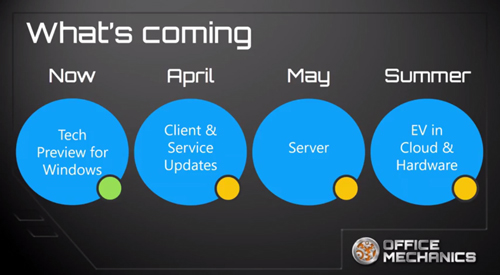News
Skype for Business Rollout Will Start on April 14
- By Gladys Rama
- April 02, 2015
Microsoft's next-generation unified communications (UC) product will be rolled out to qualified users as part of this month's Patch Tuesday update.
"Skype for Business will roll out as an update to Lync on April 14th as part of Office monthly updates," Microsoft announced in a blog post Wednesday. The update will apply to Lync Online users who have Office 2013 or are subscribed to Office 365 ProPlus or Office 365 Business Premium. For those users, the new Skype for Business user interface "will be the default user experience."
The update will not affect Lync Server users, however. "If you are using Lync Server today, the Lync UI will be the default experience," according to Microsoft.
For users and administrators who want to delay when they receive the update, Microsoft has added some controls, the post said:
The good news is that regardless of whether you are using Lync Online or Lync Server, you have the ability to control when the updated experience is rolled out to your users. There are two ways to do this. First, Office 365 ProPlus and Office 2013 allow you to control when monthly updates are delivered to your users. Second, both the online service and the server now have policy settings to control the user experience using PowerShell. While the settings are slightly different for online and server customers, both are straightforward, and allow you to manage the UI centrally.
Skype for Business is the next version of Microsoft's UC product family, previously called Lync. Microsoft announced the rebranding last November. Since mid-March, Skype for Business has been available only as a technical preview.
BJ Haberkorn, director of Skype for Business at Microsoft, gave a few more details about the company's Skype for Business roadmap in this Microsoft-produced video (see screenshot below).

The update on April 14 applies to the Skype for Business Windows client, as well as to the online service. Microsoft intends to deliver the update to iOS and Android devices "over the next few months," Haberkorn said.
On May 1, Skype for Business Server will be available for download. The server will include new high-availability features, such as SQL Server AlwaysOn support, according to Haberkorn.
After that, Microsoft plans to release a technical preview of new enterprise voice features in Skype for Business. According to Haberkorn, these features fall under two categories, the first being "the feature set that you need to eliminate PBX phones and PBX systems for users," and the second being "the ability to call phone numbers worldwide, make and receive phone calls." The technical preview of these enterprise voice features will be available to U.S. customers sometime this summer, with general availability expected by year's end.
In the later part of this year, Microsoft also plans to make changes to its ExpressRoute service to support "real-time media." Launched last spring, ExpressRoute lets organizations connect to Azure cloud services through a private network, bypassing the public cloud. In March, Microsoft announced that it will enable ExpressRoute connections to Office 365 sometime in the third quarter of 2015.
The planned enhancements to ExpressRoute will improve the quality of voice and video calls enabled by Skype for Business, according to Haberkorn. "For real-time media, you want the ability to manage the experience end to end. One of the things we'll do with carrier partners working on ExpressRoute is enable quality-of-service markings to go end to end, for voice, for video, for sharing, which allows you to ensure a great experience for people using Skype for Business," he said.
Besides sharing roadmap details, Haberkorn also showed some changes coming to the Skype for Business client UI with the April 14 update. The new UI combines the "best of Skype and Lync," he said, adding that it takes advantage "of the familiarity of the hundreds of millions of people that use Skype every month to make Skype for Business really easy to adopt." The video-calling feature, for instance, combines the traditional Skype UI with Lync controls.
New features include directory search capabilities, as well as video connectivity to Skype users.